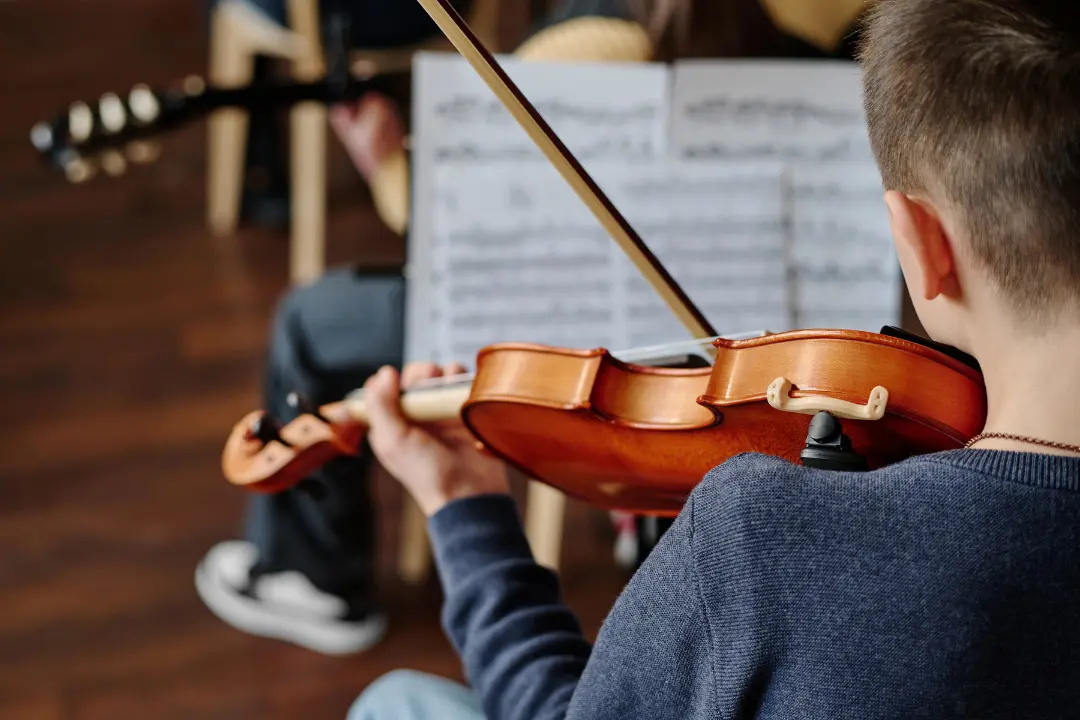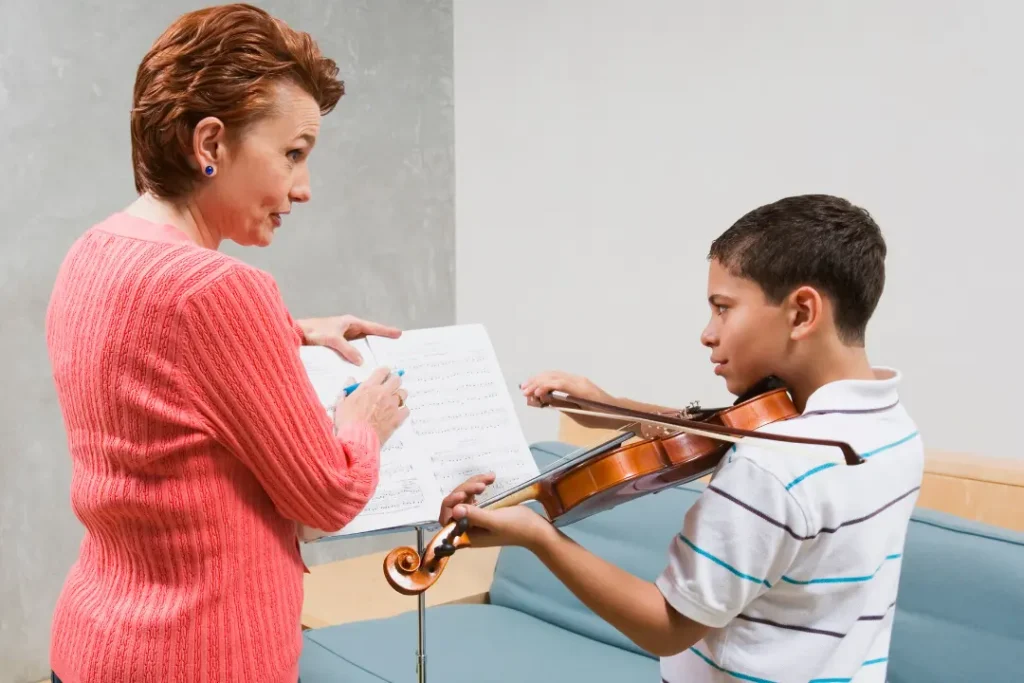
The violin is one of the most expressive and timeless instruments in the world. Whether you’re an adult beginner fulfilling a lifelong dream or a parent seeking lessons for your child, learning the violin opens the door to creativity, discipline, and emotional expression.
At Gilbert School of Music, students of all ages and skill levels can explore personalized violin programs designed to nurture passion, patience, and progress. This guide will walk you through everything you need to know before starting your violin journey — from preparing your first lesson to developing effective practice habits.
Learning the violin is more than just mastering an instrument — it’s about developing a deeper connection with music and oneself. The violin’s expressive range and versatility allow players to convey emotion, tell stories, and build focus and confidence along the way. Whether you dream of performing on stage or simply want a meaningful creative outlet, the violin offers countless rewards for students of all ages.
The violin’s rich tone and emotional depth make it one of the most beautiful instruments in the world. From classical concertos and folk music to pop and jazz, the violin fits seamlessly across genres. Learning to play it not only builds a deep appreciation for music but also helps students understand melody, harmony, and rhythm on a profound level.
Playing the violin stimulates both sides of the brain, enhancing memory, coordination, and problem-solving skills. It’s a mental workout that also provides emotional release — allowing players to express feelings that words can’t always convey. As one of the must-try music lessons, violin practice helps students develop improved focus, patience, and emotional resilience through regular playing.
Learning any instrument takes time, and the violin is no exception. But the process builds discipline, patience, and perseverance. Each milestone — from producing your first clear note to mastering a piece — boosts confidence and a sense of achievement. These qualities benefit students not just in music but in every area of life.

Starting violin lessons is an exciting milestone, but preparation plays a key role in setting you up for success. From choosing the right instrument to creating a positive learning mindset, taking time to prepare ensures that your first lesson is both productive and enjoyable. Whether you’re a complete beginner or returning to music after a break, these steps will help you feel confident and ready to begin your journey.
Before starting lessons, it’s essential to find the correct violin size. Violins come in various sizes to fit different age groups — from 1/16 for young children to full size (4/4) for adults. The right size ensures comfort and proper posture. Your instructor at Gilbert School of Music can help you choose the best instrument for your needs and budget.
To get the best start, you’ll need a few essential accessories that support proper technique and maintenance. These include a well-balanced bow, rosin for the strings, a shoulder rest for comfort, a music stand, and a tuner or tuning app. Investing in quality accessories can greatly improve your sound and make practice more enjoyable. Many music stores and schools offer beginner packages, but your instructor can also recommend specific brands and tools that are reliable for your skill level.
Your first violin lesson will focus on the basics — meeting your instructor, learning the correct way to hold the violin and bow, and understanding proper posture. Don’t be discouraged if it feels unfamiliar or challenging at first; even the best violinists started with learning how to produce a clear, steady note. Be open to guidance, ask questions, and enjoy the process of discovery. Remember, your first lesson is not about perfection — it’s about building a foundation for everything that comes next.
Before diving into lessons, it’s helpful to set clear and realistic goals that reflect what you want to achieve. Perhaps you dream of playing classical pieces, joining a local orchestra, or simply learning personal enjoyment. Sharing your goals with your instructor helps them tailor each lesson to your interests and pace. Setting small milestones along the way — like mastering scales or performing a simple song — keeps you motivated and gives you a sense of accomplishment as you progress.
Learning the violin takes patience, focus, and consistent effort. Every practice session builds your technique, listening skills, and confidence. Below are some practical tips to consider that will help you practice more effectively, progress faster, and stay motivated throughout your musical journey.
It can be tempting to rush through a song to reach the end, but speed often leads to sloppy playing and tension. Begin slowly, focusing on producing a clean, resonant tone with each note. When you prioritize sound quality from the start, your fingers and bow naturally develop precision and control, laying a strong foundation for future progress.
Large pieces can feel overwhelming at first but breaking them into smaller parts makes them easier to master. Focus on one phrase, measure, or passage at a time until it feels natural. Once you’ve perfected each section, gradually put them together—this method ensures accuracy and builds confidence with every step.
Timing is the heartbeat of music, and using a metronome helps strengthen your rhythmic accuracy. Start at a slow tempo and increase the speed gradually as your comfort grows. Over time, your internal sense of timing will improve, allowing you to stay steady even without the metronome.
Recording your practice sessions is a powerful way to monitor your growth. Listening back helps you catch details you might miss while playing—like uneven rhythm, unclear notes, or bowing inconsistencies. Over time, you’ll hear clear progress in tone and technique, which can be incredibly motivating.
Proper posture is key to both comfort and performance quality. Keep your shoulders relaxed, your back straight, and your hands free of unnecessary tension. Playing in a relaxed, natural position not only prevents injury but also enhances tone and overall ease of movement.
You don’t need to practice for hours at a time to see results. Short, focused sessions done consistently are far more effective than infrequent marathon practices. Even 15 minutes of mindful playing each day helps build muscle memory, confidence, and steady progress.
Balance is important in practice. Mix your technical drills and scales with advanced violin techniques and songs or melodies you genuinely enjoy playing. This keeps your sessions engaging and reminds you why you started learning the violin in the first place — for the joy of making music.

Every musician experiences moments where improvement feels out of reach, but these plateaus are a natural part of growth. Celebrate small victories, such as mastering a difficult passage or improving your tone. Listening to inspiring violinists or revisiting your favorite songs can rekindle your enthusiasm and remind you of your long-term goals.
Parents play a vital role in helping young learners stay consistent and inspired. Encourage a regular practice schedule, praise effort rather than perfection, and create a positive environment for learning. Turning music into a shared family experience — like listening to performances together or celebrating small milestones — makes the journey even more rewarding.
Choosing the right music school is a key step in your violin learning journey. The right environment, teachers, and programs can make all the difference in how enjoyable and effective your lessons are. Below are some important factors to consider when selecting a school that aligns with your goals, schedule, and learning style.
The quality of instruction plays a major role in your progress, so it’s essential to find a school with experienced and passionate teachers. Look for instructors who not only have strong musical backgrounds but also know how to make lessons engaging and easy to follow. Reading online reviews, visiting the school, or booking a trial class can help you gauge whether their teaching approach fits your learning needs.
Every student learns differently, so flexibility in lesson format and scheduling is important. Some schools offer private, semi-private, or group sessions, while others provide both in-person and online classes for added convenience. Choosing a school that accommodates your availability and learning pace ensures you can stay consistent and motivated over time.
After finding a music school that aligns with your goals, the next step is to begin the enrollment process. Most schools offer trial lessons or consultations to help match you with the right instructor and schedule. Once you’re enrolled, come prepared with your instrument, enthusiasm, and an open mind — this positive attitude will set the stage for a fun and rewarding musical journey ahead.
Learning the violin is an exciting experience that requires the right mix of guidance, patience, and encouragement. At Gilbert School of Music, students receive the support they need to grow both technically and creatively. With expert instructors and a personalized approach, the school helps every learner build confidence, enjoy the process, and reach their musical goals.
At Gilbert School of Music, every student receives a learning plan customized to their needs, age, and experience level. Whether you’re a young beginner discovering the violin for the first time or an adult reigniting your love for music, our programs adjust to your pace and goals. This personalized approach ensures that each student builds a strong foundation while enjoying every step of their musical journey.
Our highly trained instructors bring both expertise and enthusiasm to every lesson. They understand that learning the violin can be challenging, so they make the process engaging and encouraging. By blending technical training with creativity, our teachers help students develop strong skills while keeping the joy of music alive in every session.
We understand that every student’s schedule and goals are different. That’s why Gilbert School of Music offers flexible options — including private, semi-private, and group lessons — designed to fit your lifestyle. Whether you aim to perform on stage, join an ensemble, or simply learn for personal fulfillment, our adaptable programs make it easy to stay consistent and motivated.
Learning the violin is a rewarding journey that combines creativity, focus, and self-expression. With the right mindset, consistent practice, and guidance from dedicated instructors, anyone can learn to play beautifully.
If you’re ready to begin your musical journey, Gilbert School of Music is here to guide you every step of the way — from your very first lesson to performing your favorite pieces with confidence.
Start your violin lessons today! Visit Gilbert School of Music to learn more and enroll.
Children as young as four or five can begin learning the violin, as this is when they start developing the coordination and focus needed to play. However, it’s never too late for teens or adults to start their musical journey. What matters most is enthusiasm and a willingness to learn, not age.
Not right away. Many schools, including Gilbert School of Music, offer guidance on renting or purchasing the right instrument for your level. Starting with a rental is often a smart choice until you’re sure about your preferred violin size and comfort.
Aim for at least 15 to 30 minutes of focused practice each day. Short, consistent sessions are more effective than long, irregular ones. Over time, daily practice helps strengthen your technique, memory, and confidence with the instrument.
With steady practice, most beginners can play simple songs within a few months. Developing solid technique and musical understanding takes longer, usually a year or more. Everyone progresses at their own pace, so patience and consistency are key.
If your child shows curiosity about music, enjoys listening to melodies, and can focus for short periods, they’re probably ready to start. Physical readiness, such as being able to hold the violin comfortably, also plays a role. A trial lesson is a great way to see if they enjoy the experience and feel motivated to continue.
